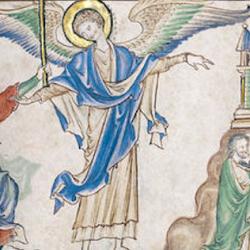Who is the “angel” through whom Jesus signifies His apocalypse? We get a clue from the unusual phrase “His angel” (1:1). This is one of two places in Revelation that use the phrase “His angel” (cf. 22:6). Here His is specifically Jesus’. In 22:6, the antecedent is harder to determine. Who is the “Lord, the God of the spirits of the prophets”? Maybe Jesus, but also maybe the Father. In either case, though, the angel is the angel of God, and in 1:1 clearly the angel of Jesus Himself. In 22:16, Jesus speaks of “My angel.”
Now, what would it mean for Jesus to have an “angel” that can be called “His”? When the Old Testament uses this language of “Yahweh’s Angel” it is talking about the Second Person of the Trinity. These are pre-incarnate appearances of Christ (Gen 24:7, 40; Daniel 3:28; 6:22). But what does it mean for Jesus Himself to have an “angel”? Acts 12:15 might help out here. There, Peter appears at the door after being released from prison, and the people in the house don’t think it’s Peter but rather “his angel.” Peter’s angel is his ghost, his spirit, the “messenger” that comes from Peter but is not Peter in the flesh. Matthew 18:10 speaks of little ones who also have “angels that “continually see the face of My Father who is in heaven.” Thus, the spirit of a man can be described as an angel.
On this basis, we might conclude that Jesus’ angel is His Spirit, the messenger that comes from Him but is not exactly identical to Him yet is His presence. That is, the Spirit.










